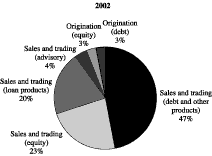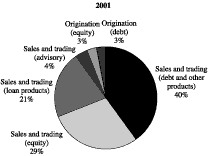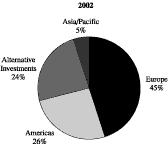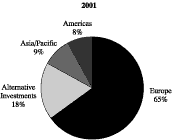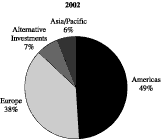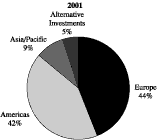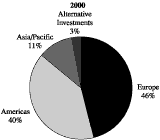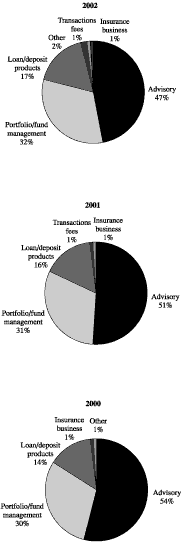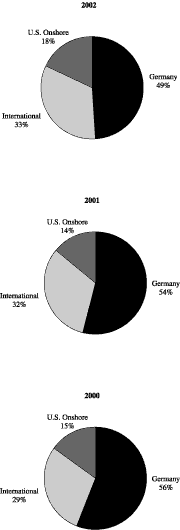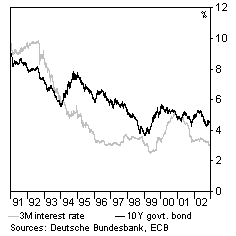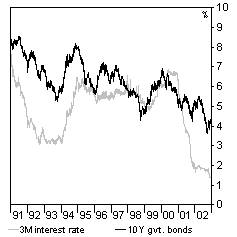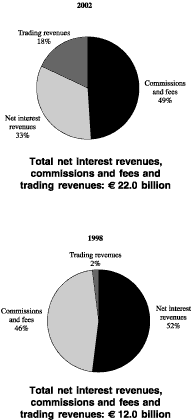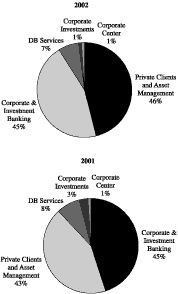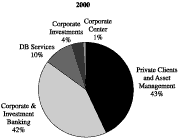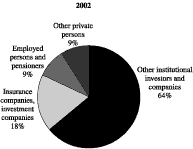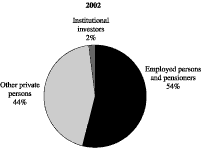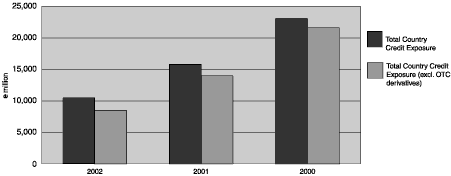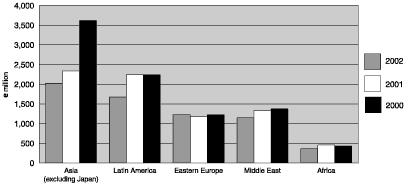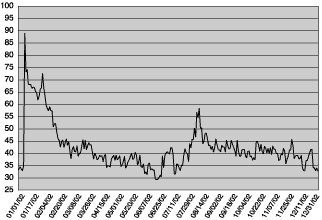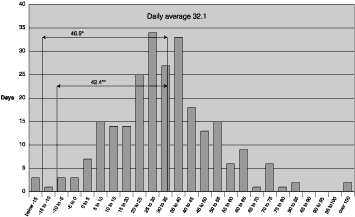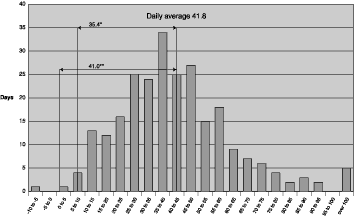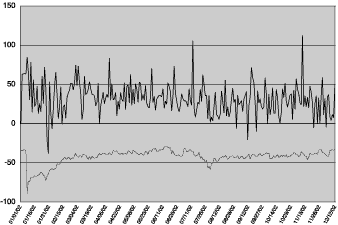DEUTSCHE BANK AKTIENGESELLSCHAFT
NOTES TO THE CONSOLIDATED FINANCIAL STATEMENTS Note 1 — Significant Accounting Policies Deutsche Bank Aktiengesellschaft (“Deutsche Bank” or the “Parent”) is a stock corporation organized under the laws of the Federal Republic of Germany. Deutsche Bank together with all majority-owned subsidiaries (the “Group”) is a global provider of a full range of corporate and investment banking, private clients and asset management products and services. For a discussion of the Group’s business segment information, see Note 28. The accompanying consolidated financial statements are stated in euros and have been prepared in accordance with accounting principles generally accepted in the United States of America (“U.S. GAAP”). Certain prior period amounts have been reclassified to conform to the current presentation. The preparation of financial statements in conformity with U.S. GAAP requires management to make estimates and assumptions that affect the reported amounts of assets and liabilities and disclosure of contingent assets and liabilities at the balance sheet date, and the reported amounts of revenue and expenses during the reporting period. Actual results could differ from management’s estimates. The following is a description of the significant accounting policies of the Group. Principles of Consolidation and Other Investments The consolidated financial statements include Deutsche Bank together with all majority-owned
subsidiaries. All material intercompany transactions and accounts have been eliminated. Investments in enterprises are accounted for using the equity method when the Group is not the majority owner but has the ability to significantly influence operating and financial policies of the investee. Generally, this is when the Group has an investment between 20% and 50% of the voting stock of a corporation or 3% or more of a limited partnership. Other factors that are considered in determining whether the Group has significant influence include representation on the board of directors (supervisory board in the case of German stock corporations) and material intercompany transactions. These investments are reported in other investments and the pro-rata share of their income or loss, on a U.S. GAAP basis, as well as disposition gains and losses, are included in net income from equity method investments. Equity method losses in excess of the Group’s carrying amount of the investment in the enterprise are charged against other assets held by the Group related to the investee. Prior to January 1, 2002, the difference between the Group’s cost and its proportional underlying equity in net assets of the investee at the date of investment (“equity method goodwill”) was amortized on a straight-line basis against net income from equity method investments over a period not exceeding fifteen years. Effective January 1, 2002, the Group adopted SFAS No. 142, “Goodwill and Other Intangible Assets” (“SFAS 142”). In accordance with SFAS 142, equity method goodwill is no longer amortized. Special Purpose Entities (“SPEs”) are legal entities created for a particular purpose and are used in structuring a wide range of capital markets products. Unless the SPE meets the criteria for a Qualifying Special Purpose Entity (“QSPE”) as defined in SFAS No. 140, “Accounting for Transfers and Servicing of Financial Assets and Extinguishments of Liabilities” (“SFAS 140”) (see Asset Securitizations below), the Group consolidates SPEs when it is deemed to control and/or retain the majority of the risks and rewards of the SPE. The underlying holdings of designated investment companies that are consolidated are included in other investments, as they are primarily nonmarketable equity securities, and are carried at fair value. Changes in fair value of the underlying holdings are included in other revenues. F-8
DEUTSCHE BANK AKTIENGESELLSCHAFT
NOTES TO THE CONSOLIDATED FINANCIAL STATEMENTS—(Continued) Direct investments over which the Group does not have significant influence, including investments in venture capital companies and nonmarketable equity securities, are included in other investments and carried at historical cost, net of declines in fair value below cost that are deemed to be other than temporary. Gains and losses upon sale or impairment are included in other revenues. Foreign Currency Translation Assets and liabilities denominated in currencies other than an entity’s functional currency are translated into its functional currency using the period end exchange rates, and the resulting transaction gains and losses are reported in noninterest revenues or noninterest expenses. In consolidation, the financial statements of entities with functional currencies other than the euro are translated into the euro and the resulting translation gains and losses, net of any hedge and tax effects, are reported in accumulated other comprehensive income within shareholders’ equity. Revenues and expenses are translated at the weighted average rate during the year whereas assets and liabilities are translated at the period end rate. Reverse Repurchase and Repurchase Agreements Securities purchased under resale agreements (“reverse repurchase agreements”) and securities sold under agreements to repurchase (“repurchase agreements”) are generally treated as collateralized financings and are carried at the amount of cash disbursed and received, respectively. Generally, the party disbursing the cash takes possession of the securities serving as collateral for the financing. Securities purchased under resale agreements consist primarily of OECD country sovereign bonds or sovereign guaranteed bonds. Securities owned and pledged as collateral under repurchase agreements in which the counterparty has the right by contract or custom to sell or repledge the collateral are disclosed on the Consolidated Balance Sheet in accordance with SFAS 140. The Group monitors the fair value of the securities received or delivered. For securities purchased under resale agreements, the Group requests additional securities or the return of a portion of the cash disbursed when appropriate in response to a decline in the market value of the securities received. Similarly, the return of excess securities or additional cash is requested when appropriate in response to an increase in the market value of securities sold under repurchase agreements. The Group offsets reverse repurchase and repurchase agreements with the same counterparty which meet the applicable netting criteria in FASB Interpretation No. 41, “Offsetting of Amounts Related to Certain Repurchase and Reverse Repurchase Agreements” (“FIN 41”). Interest earned on reverse repurchase agreements and interest incurred on repurchase agreements are reported as interest revenues and interest expense, respectively. Securities Borrowed and Securities Loaned Securities borrowed and securities loaned are recorded at the amount of cash advanced or received. Securities borrowed transactions generally require the Group to deposit cash with the securities lender. In a securities loaned transaction, the Group generally receives either cash collateral, in an amount equal to or in excess of the market value of securities loaned, or securities. If the securities received may be sold or repledged, they are accounted for as trading assets and a corresponding liability to return the security is recorded. The Group monitors the fair value of securities borrowed and securities loaned and additional collateral is obtained, if necessary. Fees received or paid are reported in interest revenues and interest expense, respectively. Securities owned and pledged as collateral under F-9
DEUTSCHE BANK AKTIENGESELLSCHAFT
NOTES TO THE CONSOLIDATED FINANCIAL STATEMENTS—(Continued) securities lending agreements in which the counterparty has the right by contract or custom to sell or repledge the collateral are disclosed on the Consolidated Balance Sheet in accordance with SFAS 140. Loans Held for Sale, Trading Assets and Liabilities, and Securities Available for Sale Loans held for sale are accounted for at the lower of cost or market and are reported as trading assets. The Group designates debt and marketable equity securities as either held for trading purposes or available for sale at the date of acquisition. Trading assets, except for loans held for sale, and trading liabilities are carried at their fair values and related realized and unrealized gains and losses are included in trading revenues. Securities available for sale are carried at fair value with the changes in fair value reported in accumulated other comprehensive income within shareholders’ equity unless the security is subject to a fair value hedge, in which case changes in fair value resulting from the risk being hedged are recorded in other revenues. The amounts reported in other comprehensive income are net of deferred income taxes and adjustments to insurance policyholder liabilities and deferred acquisition costs. Declines in fair value of securities available for sale below their amortized cost that are deemed to be other than temporary and realized gains and losses are reported in the Consolidated Statement of Income in net gains on securities available for sale. The amortization of premiums and accretion of discounts are recorded in interest revenues. Generally, the weighted-average cost method is used to determine the cost of securities sold. Fair value is generally based on quoted market prices, price quotes from brokers or dealers or discounted expected cash flows. Derivatives All freestanding contracts considered to be derivatives for purposes of SFAS No. 133, “Accounting for Derivative Instruments and Hedging Activities” (“SFAS 133”) are carried at fair value in the balance sheet regardless of whether they are held for trading or nontrading purposes. Derivative features embedded in other contracts that meet certain criteria are also measured at fair value. Fair values for derivatives are based on quoted market prices or pricing models which take into account current market and contractual prices of the underlying instruments as well as time value and yield curve or volatility factors underlying the positions. Fair values also take into account expected market risks, modeling risks, administrative costs and credit considerations. Assets and liabilities arising from contracts covered by qualifying master netting agreements are reported on a net basis, in accordance with FASB Interpretation No. 39, “Offsetting of Amounts Related to Certain Contracts” (“FIN 39”). The Group enters into various contracts for trading purposes, including swaps, futures contracts, forward commitments, options and other similar types of contracts and commitments based on interest and foreign exchange rates, and equity and commodity prices. Such positions are carried at their fair values as either trading assets or trading liabilities, and related gains and losses are included in trading revenues. Derivative features embedded in other nontrading contracts are measured separately at fair value when they are not clearly and closely related to the host contract and meet the definition of a derivative. Unless designated as a hedge, changes in the fair value of such an embedded derivative are reported in trading revenues. The carrying amount is reported on the Consolidated Balance Sheet with the host contract. F-10
DEUTSCHE BANK AKTIENGESELLSCHAFT
NOTES TO THE CONSOLIDATED FINANCIAL STATEMENTS—(Continued) Certain derivatives entered into for nontrading purposes, not qualifying for hedge accounting, that are otherwise effective in offsetting the effect of transactions on noninterest revenues and expenses are recorded in other assets or other liabilities with changes in fair value recorded in the same noninterest revenues and expense captions affected by the transaction being offset. The changes in fair value of all other derivatives not qualifying for hedge accounting are recorded in trading revenues. Beginning January 1, 2001, the Group has applied hedge accounting in accordance with SFAS 133. There are three possible types of hedges under this standard, each of which is accounted for differently: (1) fair value hedges, (2) cash flow hedges, and (3) hedges of net investments in foreign operations. For fair value hedges, changes in the fair value of the hedged asset or liability due to the risk being hedged are recognized in earnings along with changes in the entire fair value of the derivative. When hedging interest rate risk, for both the derivative and the hedged item any interest accrued or paid is reported in interest income or expense and the unrealized gains and losses from the fair value adjustments are reported in other revenues. When hedging the foreign exchange risk in an available-for-sale security, the fair value adjustments related to the foreign exchange exposures are also recorded in other revenues. Hedge ineffectiveness is reported in other revenues and is measured as the net effect of the fair value adjustments made to the derivative and the hedged item arising from changes in the market rate or price related to the risk being hedged. If a fair value hedge is canceled because the derivative is terminated or de-designated, any remaining interest rate related fair value adjustment made to the carrying amount of a hedged debt instrument is amortized to interest over the remaining life of the original hedge. For other types of fair value adjustments or anytime the hedged asset or liability is sold or terminated, any basis adjustments are included in the calculation of the gain or loss on sale or termination. For cash flow hedges, there is no special accounting for the hedged item and the derivative is carried at fair value with changes in value reported initially in other comprehensive income to the extent the hedge is effective. These amounts initially recorded in other comprehensive income are subsequently reclassified into earnings in the same periods during which the forecasted transaction affects earnings. Thus, for hedges of interest rate risk the amounts are amortized into interest revenues or expense along with the interest accruals on the hedged transaction. When hedging the foreign exchange risk in an available- for-sale security, the amounts resulting from foreign exchange risk are included in the calculation of the gain or loss on sale once the hedged security is sold. Hedge ineffectiveness for cash flow hedges is recorded in other revenues and is generally measured as the difference between the changes in fair value of the actual hedging derivative and a hypothetically perfect hedge. When cash flow hedges of interest rate risk are canceled, amounts remaining in accumulated other comprehensive income are amortized to interest revenues or expense over the original life of the hedge. For cancellations of other types of cash flow hedges, the related amounts accumulated in other comprehensive income are reclassified into earnings either in the same income statement caption and period as the forecasted transaction, or in other revenues when it is no longer probable that the forecasted transaction will occur. For hedges of net investments in foreign operations, the portion of the change in fair value of the derivative due to changes in the spot foreign exchange rate is recorded as a foreign currency translation adjustment in other comprehensive income to the extent the hedge is effective, the remainder is recorded as other revenues. F-11
DEUTSCHE BANK AKTIENGESELLSCHAFT
NOTES TO THE CONSOLIDATED FINANCIAL STATEMENTS—(Continued) Any derivative de-designated as a hedge is transferred to trading assets and liabilities and marked to market with changes in fair value recognized in trading revenues. For any hedging derivative that is terminated, the difference between the derivative’s carrying amount and the cash paid or received is recognized as other revenues. Prior to 2001, most of the derivatives entered into for nontrading purposes, although considered effective as economic hedges, did not qualify for hedge accounting mainly due to contemporaneous documentation requirements that could not be fulfilled when initially adopting U.S. GAAP after the fact. Consequently, these derivatives have been accounted for as trading derivatives, that is, they are marked to market and the changes in fair value are reported in trading revenues. In addition, for periods prior to January 1, 2001, hedge accounting was different for the limited cases where it was applied for certain interest rate and foreign currency hedges. Interest rate swaps were accounted for as off-balance sheet transactions with interest payable or receivable recorded on an accrual basis. For cross currency interest rate swaps, interest was accrued and the foreign currency notional amount of the swaps was translated at spot rates with the resulting gain or loss reported in earnings. No special accounting was applied to the hedged items. Loans Loans generally are carried at their outstanding unpaid principal balances net of charge- offs, unamortized premiums or discounts, and deferred fees and costs on originated loans. Interest revenues are accrued on the unpaid principal balance net of charge-offs. Net deferred fees and premiums or discounts are recorded as an adjustment of the yield (interest revenues) over the lives of the related loans. Loans are placed on nonaccrual status if either the loan has been in default as to payment of principal or interest for 90 days or more and the loan is neither well secured nor in the process of collection; or the loan is not yet 90 days past due, but in the judgment of management the accrual of interest should be ceased before 90 days because it is probable that all contractual payments of interest and principal will not be collected. When a loan is placed on nonaccrual status, any accrued but unpaid interest previously recorded is reversed against current period interest revenues. Cash receipts of interest on nonaccrual loans are recorded as either interest revenues or a reduction of principal according to management’s judgment as to the collectability of principal. Leasing Transactions Lease financing transactions, which include direct financing and leveraged leases, in which a Group entity is the lessor are classified as loans. Unearned income is amortized to interest revenues over the lease term using the interest method. Capital leases in which a Group entity is the lessee are capitalized as assets and reported in premises and equipment. Allowances for Credit Losses The allowances for credit losses represent management’s estimate of probable losses that have occurred in the loan portfolio and other lending-related commitments as of the date of the consolidated financial statements. The allowance for loan losses is reported as a reduction of loans and the allowance for credit losses on lending-related commitments is reported in other liabilities. To allow management to determine the appropriate level of the allowance for loan losses, all significant counterparty relationships are reviewed periodically, as are loans under special supervision, such as impaired loans. Smaller-balance standardized homogeneous loans are collectively evaluated for impairment. This review encompasses current information F-12
DEUTSCHE BANK AKTIENGESELLSCHAFT
NOTES TO THE CONSOLIDATED FINANCIAL STATEMENTS—(Continued) and events related to the counterparty, as well as industry, geographic, economic, political, and other environmental factors. This process results in an allowance for loan losses which consists of a specific loss component and an inherent loss component. The specific loss component is the allowance for impaired loans as calculated under SFAS No. 114, “Accounting by Creditors for Impairment of a Loan” as amended by SFAS No. 118, “Accounting by Creditors for Impairment of a Loan—Income Recognition and Disclosures” (collectively “SFAS 114”). Impaired loans represent loans for which, based on current information and events, management believes it is probable that the Group will not be able to collect all principal and interest amounts due in accordance with the contractual terms of the loan agreement. The specific loss component of the allowance is measured by the excess of the recorded investment in the loan, including accrued interest, over either the present value of expected future cash flows, the fair value of the underlying collateral or the market price of the loan. Impaired loans are generally placed on nonaccrual status. The inherent loss component is for all other loans not individually evaluated but that, on a portfolio basis, are believed to have some inherent loss, in accordance with SFAS No. 5, “Accounting for Contingencies” (“SFAS 5”). The inherent loss component consists of an allowance for country risk, an allowance for smaller-balance standardized homogeneous exposures and an other inherent loss component. The country risk component is for loan exposures in countries where there are serious doubts about the ability of counterparties to comply with the repayment terms due to the economic or political situation prevailing in the respective country of domicile, that is, for transfer and currency convertibility risks. The allowance for smaller-balance standardized homogeneous exposures is established for loans to individuals and small business customers of the private and retail business. These loans are evaluated for inherent loss on a collective basis, based on analyses of historical loss experience from each product type according to criteria such as past due status and collateral recovery values. The other inherent loss component represents an estimate of inherent losses resulting from the imprecisions and uncertainties in determining credit losses. Loans subject to this component of the allowance exclude those that have been determined to be impaired under SFAS 114. This component is determined by calculating the ratio of an entity’s historical average loan losses (net of recoveries) to the historical average of its loan exposures, applying the resulting ratio to the corresponding period end loans and adjusting the results for relevant environmental factors. During 2002, the measurement of the other inherent loss component was refined to incorporate an expected loss measure, which considers among other factors, collateral, maturities, and long-term statistical averages of default and loss history. This refinement was made in order to make the provision more sensitive to the prevailing credit environment and less based on historical loss experience. Amounts determined to be uncollectable are charged to the allowance. Subsequent recoveries, if any, are credited to the allowance. The provision for loan losses, which is charged to income, is the amount necessary to adjust the allowance to the level determined through the process described above. The allowance for credit losses on lending-related commitments is determined using the same measurement techniques as the allowance for loan losses. Asset Securitizations When the Group transfers financial assets to securitization trusts in securitizations of mortgage or other loan portfolios, it may retain one or more subordinated tranches, cash reserve accounts, or in some cases, servicing rights or interest-only strips, all of which are retained interests in the securitized assets. The amount of the gain or loss on transfers accounted for as sales depends in part on the previous carrying amounts of the financial assets involved in the transfer, allocated between the assets sold and the retained interests F-13
DEUTSCHE BANK AKTIENGESELLSCHAFT
NOTES TO THE CONSOLIDATED FINANCIAL STATEMENTS—(Continued) based on their relative fair values at the date of transfer. Retained interests other than servicing rights are classified as trading assets, securities available for sale or other assets depending on the nature of the retained interest and management intent. Servicing rights are classified in intangible assets, carried at the lower of the allocated basis or current fair value and amortized in proportion to and over the period of net servicing revenue. To obtain fair values, quoted market prices are used if available. However, for securities representing retained interests from securitizations of financial assets, quotes are often not available, so the Group generally estimates fair value based on the present value of future expected cash flows using management’s best estimates of the key assumptions (loan losses, prepayment speeds, forward yield curves, and discount rates) commensurate with the risks involved. Interest revenues on retained interests is recognized using the effective yield method. Securitization trusts that meet the criteria for QSPEs, as defined in SFAS 140, are not consolidated. Premises and Equipment Premises and equipment are stated at cost less accumulated depreciation. Depreciation is generally computed using the straight-line method over the estimated useful lives of the assets. The range of estimated useful lives is 25 to 50 years for premises and 3 to 10 years for furniture and equipment. Leasehold improvements are depreciated on a straight-line basis over the shorter of the term of the lease or the estimated useful life of the improvement, which is generally 3 to 15 years. Depreciation of premises is included in net occupancy expense of premises, while depreciation of equipment is included in furniture and equipment expense or IT costs. Maintenance and repairs are charged to expense and improvements are capitalized. Gains and losses on dispositions are reflected in other revenues. Leased properties meeting certain criteria are capitalized as assets in premises and equipment and depreciated over the terms of the leases. Eligible costs related to software developed or obtained for internal use are capitalized and depreciated using the straight-line method over a period of 3 to 5 years. Eligible costs include external direct costs for materials and services, as well as payroll and payroll related costs for employees directly associated with an internal-use software project. Overhead, as well as costs incurred during planning or after the software is ready for use, is expensed as incurred. Goodwill and Other Intangible Assets Prior to January 1, 2002, goodwill and other intangible assets, which includes servicing rights related to asset securitizations, were amortized over their estimated useful lives. Goodwill, which represents the excess of cost over the fair value of net assets acquired at the date of acquisition, was amortized on a straight-line basis over a period not exceeding fifteen years. In accordance with SFAS 142, as of January 1, 2002, goodwill is no longer amortized and is tested for impairment annually, or more frequently if events or changes in circumstances indicate that the goodwill may be impaired, such as an adverse change in business climate. Other intangible assets in existence at January 1, 2002, have a finite useful life and continue to be amortized over a period of 3 to 15 years. In addition, other intangible assets acquired subsequent to January 1, 2002, that were determined to have an indefinite useful life, primarily investment management agreements related to retail mutual funds, are not amortized and are tested for impairment at least annually. F-14
DEUTSCHE BANK AKTIENGESELLSCHAFT
NOTES TO THE CONSOLIDATED FINANCIAL STATEMENTS—(Continued) Impairment Securities available for sale, equity method and direct investments (including investments in venture capital companies and nonmarketable equity securities) are subject to impairment reviews. An impairment charge is recorded if a decline in fair value below the asset’s amortized cost or carrying value, depending on the nature of the asset, is deemed to be other than temporary. Other intangible assets with finite useful lives and premises and equipment are also subject to impairment reviews if a change in circumstances indicates that the carrying amount of an asset may not be recoverable. If estimated undiscounted cash flows relating to an asset held and used are less than its carrying amount, an impairment charge is recorded to the extent the fair value of the asset is less than its carrying amount. For an asset to be disposed of by sale, a loss is recorded based on the lower of the asset’s carrying value or fair value less cost to sell. An asset to be disposed of other than by sale is considered held and used and accounted for as such until it is disposed of. Prior to January 1, 2002, goodwill was subject to an impairment review if a change in circumstances indicated that its carrying amount may not be recoverable. As of January 1, 2002, goodwill and other intangible assets which are not amortized are tested for impairment at least annually according to SFAS 142. Income Taxes The Group recognizes the current and deferred tax consequences of all transactions that have been recognized in the consolidated financial statements, using the provisions of the appropriate jurisdictions’ tax laws. Deferred tax assets and liabilities are recognized for the future tax consequences attributable to differences between the financial statement carrying amounts of existing assets and liabilities and their respective tax bases, net operating loss carryforwards and tax credits. The amount of deferred tax assets is reduced by a valuation allowance, if necessary, to the amount that, based on available evidence, management believes will more likely than not be realized. Deferred tax liabilities and assets are adjusted for the effect of changes in tax laws and rates in the period that includes the enactment date. Share-Based Compensation The Group has elected to account for its share awards under the intrinsic value-based method of accounting prescribed by Accounting Principles Board Opinion No. 25, “Accounting for Stock Issued to Employees” (“APB 25”) as permitted by SFAS No. 123, “Accounting for Stock-Based Compensation” (“SFAS 123”). Under the intrinsic value-based method, compensation expense is the excess, if any, of the quoted market price of the shares at grant date or other measurement date over the amount an employee must pay, if any, to acquire the shares. Compensation expense is recorded over the period in which employees perform services to which the awards relate. Compensation expense is reversed in the period an award is forfeited. The Group records its obligations under outstanding deferred share awards in shareholders’ equity as share awards–common shares issuable. The related deferred compensation is also included in shareholders’ equity. These classifications are based upon the Group’s intent to settle these awards with its common shares. Compensation expense for share-based awards payable in cash is remeasured based on the underlying share price changes and the related obligations are included in other liabilities until paid. F-15
DEUTSCHE BANK AKTIENGESELLSCHAFT
NOTES TO THE CONSOLIDATED FINANCIAL STATEMENTS—(Continued) The following table illustrates the effect on net income and earnings per share if the Group had applied the fair value recognition provisions of SFAS 123 to share-based awards. | 